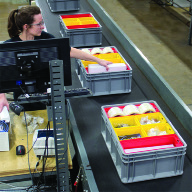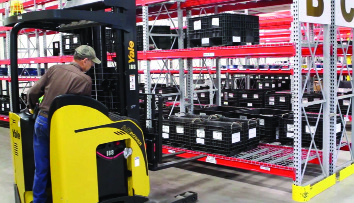Equipment Report: Outside the box thinking
The latest developments in reusable totes and containers are being underscored by customization and additional options for handling flexibility.
Although fast food slinger Burger King did away with the “have it your way” slogan a couple of years ago, the mantra might as well have been adopted by manufacturers of reusable plastic totes and bulk containers. That’s because—although standard sizes and configurations are still offered—customization is king in the industry today, says Ken Beckerman, president of Flexcon Container.
“People will still purchase a standardized, off-the-shelf tote or container, but they often discover they’re making the mistake of trying to put a round peg into a square hole,” Beckerman explains. “The container might satisfy 80% of their requirements, but when they are looking to maximize handling efficiency and speed, custom tailoring that unit is frequently the best solution.”
Customization options include an enormous range of design modifications and adaptations beyond traditional dimensional choices and material alternatives (such as polypropylene or polyethylene, electro-static dipative and fire retardant formulations). Among them, specific label and bar code placement areas to accommodate existing automation, textured bottoms for conveyor inclines and declines, crack resistant materials, reinforced and ergonomic handles, collapsible sidewalls and door openings, fold-ability, drain-ability, higher or lower weight capacity, unique colors and custom markings for branding purposes. All of these choices allow a reusable tote or container user to better optimize the handling process.
Although tote and container customization doesn’t come cheap, it can frequently save users a significant amount of money resulting from operational improvements over choosing a less expensive, standard unit, Beckerman continues.
“Every situation is different, of course, but as an example, I recently showed a customer how using standard totes in their current, $1.2-million automated storage and retrieval system (AS/RS) was wasting 19% of its available space,” he explains. “Using a custom tote engineered for them instead, they’re saving more than $200,000 by fully maximizing the usable space within their automation system.”
It’s the same story with bulk containers. The overall trend in reusable tote and container design is “developing the right product, internal dividers and dunnage specifically for the application, rather than making do with what’s out there,” adds Beckerman.
Here, Modern takes a closer look at the specific handling needs addressed by customized, reusable totes and containers.
Automated storage installations drive increased tote usage
With the move toward more and more automated materials handling and storage systems within manufacturing and distribution operations, sales of straight-wall totes and bins are up, says Bart Eggert, industrial product line manager at Akro-Mils. So, too, is the need for flexible modification of those totes to accommodate the increasing number and dimensional variability of stock keeping units (SKUs).
“Automated storage and retrieval systems are being increasingly installed here in the United States and most of the totes are based on the standard European footprint of 600 x 400 millimeters—or 23.5 x 15.75 inches—in varying heights, depending on the application,” Eggert explains. “However, users need multiple use options for a single tote to accommodate different products and processes.”
While interior dividers that allow one tote to hold multiple SKUs have been around for a while, they’re usually made of corrugated plastic. But that isn’t always a reliable solution, Eggert notes. That’s because the vibrations resulting from the totes’ travel throughout powered conveyors and in and out of automated systems can jostle a divider out of position, or cause parts to migrate under the divider walls. 
“We recently developed our Multi-Load Tote specifically for automated storage and retrieval systems with a system of very rigid, customizable length and width dividers. Another option for that tote is a variety of different sized sorting cups that clip to the inside of the sidewall and provide secure compartments to separate the contents,” he says, adding that the clip prevents the cup from rattling around or falling over. “That makes it ideal for picking multiple SKUs or kitting parts for work-in-process manufacturing operations.”
Similarly, with more robotic handling applications coming online, totes with injection-molded dunnage incorporated into the container itself—a trend long seen in Europe—can be created, says Clinton McDade, senior designer of plastic products at SSI Schaefer.
“The tolerances have to be pretty tight so that when the robot arrives, its end effector can pick up molded-in locating features on the tote to properly align all the grippers with the product inside; that sort of accuracy is hard to get from plastic corrugated dividers,” McDade explains.
Additionally, while dimensional stability is often cited as a key benefit of reusable containers for automated storage and handling applications, selecting the right custom design and material that minimizes base deflection when product is stored inside have become critical to maximizing an automated system’s performance. Even just a few millimeters of excess sagging might mean the robotic arm or extractor interfacing with the tote must retrieve it at a slower speed, or be unable to extract the tote at all.
“Further, if you’re putting totes on powered conveyors, they’ll be bumping into each other all the time,” McDade adds. “Traditional straight-wall containers often have ribs on the outer corners for strength, but the ribs will eventually fracture after repeated bumping. We now include a double-walled corner on our straight-wall models, which act sort of like a bumper car bumper to prevent that damage.”
Another custom feature that enhances operator picking speed in goods-to-person handling systems is the inclusion of a drop-door on the end wall (narrow dimension) of totes.
“We’re particularly seeing this in pharmaceutical applications, where there might be hundreds of small items to pick stored in a 9-inch-tall container,” says McDade. “It may not sound like very far to reach, but incorporating a drop door that lowers the access clearance to 4 inches reduces fatigue and minimizes the risk of an injury caused by the forearm repeatedly hitting the rim of the tote.”
Bulk container designs for mobility, handling flexibility
As with smaller totes, purchasers and users of bulk containers are also asking for customizable design features to enhance their handling practices, says Bob Petersen, vice president of product management at ORBIS Corp.
“A lot of the features we’ve been asked to create and design enhance the mobility of the containers,” he says. “We can make it easier for operators to move the container around, either by reducing the tare weight of the unit so it can be moved by hand when empty, or by adding wheels or a dolly-type system.”
The motivation, Petersen continues, is a desire to reduce the number of—and need for—forklifts within a facility. “Users want the ability to move things without having to use a fork truck or to maneuver in tight spaces and narrower aisles.” 
Making containers mobile to eliminate forklifts also protects the containers and the products stored within them. “Any kind of plastic container is not going to beat a fork truck. If the fork truck is going to hit it, then it’s going to break,” Petersen says. “If you can minimize the amount of time that packaging comes into contact with a fork truck, you’re better off.”
Adding wheels and/or casters to containers also delivers ergonomic benefits by making it easier to move loads around, says Dan Rodriguez, national sales manager at MODRoto.
“We sell a lot of containers into the healthcare industry for handling bio-hazardous waste and linens, and we’ve been asked to integrate other features that help workers with loading and unloading—including coil spring platforms within the container,” Rodriguez says.
Further, MODRoto recently introduced a fastening system with four nylon straps and release buckles that secures the lid to the container so it remains covered even when turned upside down, adds Rodriguez. “Although it can be used in any application, the system was originally engineered for users transporting healthcare linens and sharps that need to be kept safely away from workers.”
He also notes that more customers from industries including healthcare, e-commerce fulfillment centers and bulk materials handling, are asking for tow hitches (as well as wheels) integrated into their containers. This essentially turns bulk containers into carts that can be towed by automatic guided vehicles (AGVs), Rodriguez explains.
However, introduction of any new container features should be respectful of the other units used within the system, Petersen says. Because it’s expensive to replace a container system outright, suppliers like ORBIS engineer customization with an eye toward compatibility.
“We might add a new feature to support a specific handling need somewhere within a user’s broader supply chain—such as adding banding strips—but the base container design still works with the other containers they’ve had for years, or their existing automation system,” he explains.
Likewise, Petersen sees a trend toward smaller container footprints that still correlate to larger container footprints, such as half- or quarter-sized containers. “Optimizing space is always an issue, whether it’s in a warehouse, a 50-foot trailer, or navigating the last 100 feet of delivery into a retail store,” he says. “Smaller containers optimize handling of partial loads and can be easily wheeled through a narrow door.”













